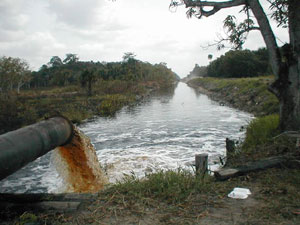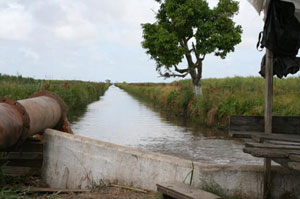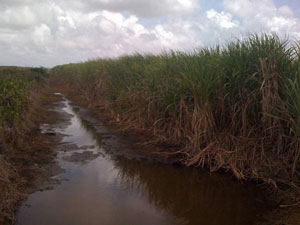Careful
planning allows planting of substantial
quantities of new cane
The first sugar cane crop of 2010 is
drawing to an end. Rose Hall and Uitvlugt
Estates have already completed the first
crop. Albion, Blairmont, Enmore, LBI and
Wales are due to complete within one to
two weeks, while Skeldon would go up to
the first week of May.

Pumping
good quality water from Kamuni
Creek
into Wales distributary canal system for
factory supply and navigation/irrigation
Average rainfall across the industry
continues to be extremely
low and evaporation losses from the large
surfaces of our extensive canal networks
are enormous. We continue to suffer from
soil moisture deficit, particularly on the
East Demerara Estates.
Prediction from the International Research
Institute for Climate and Society of the
Earth Institute, Columbia University, USA,
is that for the period April-May-June
2010, there is a 50% probability of
occurrence of ‘El Nino’ weather
conditions.
Cane growth and development has been
affected at Blairmont, Enmore, LBI and
Uitvlugt. This is more pronounced in the
saline low-lying front lands at Rose Hall
and Enmore. The Demerara Estates have had
to cut back on their re-planting programme.
The industry has had to confine irrigation
to plant canes for germination and to
plant canes two to seven months old, which
are in their boom growing period. The
least affected estates to date are Skeldon
and to a lesser extent Wales, both of
these locations were experiencing some
sporadic showers, especially Skeldon.
However, the National Drainage and
Irrigation Authority (NDIA) continues to
pump water into the East and West Demerara
Conservancies to maintain supplies for
agricultural purposes and domestic use.
Supply to East Demerara has been improved
by taking in water by gravity through the
sluice gate at Maduni during high tides
experienced last week. Similarly, the
supply at West Demerara has been improved
by building a stop-off and pumping at Two
Mouth into the Service Canal.
The East Berbice Estates continue to
receive adequate supplies of water for
factory operations, cane transport and
irrigation from the Canje Creek.
Blairmont is still obtaining water by
pumping from the MMA main canal. East
Demerara Estates are struggling to
maintain their navigation canals for
flotation of punts by pumping from the
East Demerara Conservancy. Wales Estate
continues to obtain a reliable supply of
fresh water from the Kamuni creek via
pumping.

Water
being pumped into a canal which directly
feeds the Enmore factory
All
the Estates are re-circulating water. With
the crop over at Uitvlugt Estate,
available water is currently being
channeled into areas where cane is being
planted.
Mobile pumps released from NDIA are still
in operation to supply water to Enmore,
LBI and Wales. Skeldon Estate had also
released one mobile pump to Blairmont and
one to LBI which are also utilised for
water supply.
The integrated agricultural strategy
developed and the water management
measures adopted by the industry have so
far been successful in mitigating some of
the adverse effects of the ‘El Nino’
weather conditions.
Water management Strategies implemented
includes the following: optimum water
conservation practices; recirculation/re-cycling
of water, monitoring of water availability
and quality at source; monitoring of soil
moisture; close monitoring of the
operation of water control structures;
appropriate harvesting sequence; and
appropriate crop husbandry practices.

Dry
canal in the Enmore Estate
Water conservation practices include
recirculation of water from the drainage
system into navigation canals for cane
transport
and irrigation. Sluice gates are locked
and secured to prevent intrusion of salt
water. Daily water quality monitoring is
done in areas where pumps are used for
water supply and recirculation of water.
The operation of the gates on the Torani
canal are closely monitored to ensure that
adequate amounts of water are released to
augment the supply of fresh water down
the Canje Creek for the East Berbice
Region. Check sluices and stop-offs are
used to control water levels and water
quality within the canal networks for
irrigation and transport of cane punts.
Canes are harvested in sectionalised
blocks to optimise and conserve on the use
of water. Water from canals within
harvested blocks are released and pumped
out into canals within blocks, which are
to be subsequently harvested.
By careful planning and development of an
integrated agricultural strategy which
includes stringent water conservation
measures, and by making efficient use of
available water resources, the sugar
industry has succeeded in planting
substantial quantities of new cane despite
the prolonged agricultural drought.
Since the weather can be volatile and so
as not to be caught off-guard, the
industry is already making preparations
for the anticipated May-June rains.



